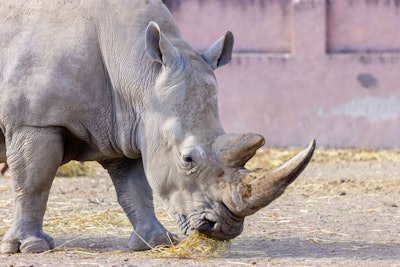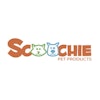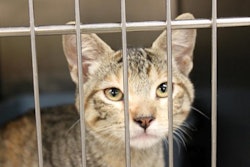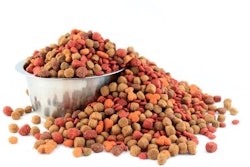
A dietary supplement from W.F. Young helped restore the health of critically endangered black rhinoceros (Diceros bicornis) living in American zoos. W.F. Young produces varieties of The Missing Link supplements for dogs, cats, horses and other animals. Veterinarians at the Kansas City Zoological Gardens used the variety meant for horses with the rhinos in 1998. The supplements are derived from flaxseed.
This article is part of a series telling astounding stories of pet food industry professionals. Do you have a hair-raising or inspirational story about your pet food company? Please, send it with the subject “Pet food story” to: [email protected].
That Missing Link supplement provided the rhinos with a ratio of the omega-6 fatty acid, linoleic acid, to the omega-3 fatty acid, alpha linolenic acid, that seemed to benefit the endangered species’ health. For rhinos and other animals, a proper ratio may be more important than the overall levels of the essential fatty acids, wrote a Kansas City zoo veterinarian and a Wildlife Conservation Society scientist in the Proceedings of the American Association of Zoo Veterinarians Conference.
The benefits of balanced fatty acid supplementation were particularly critical for one rhino, wrote the researchers. A female eastern black rhino (spp. michaeli), named Lucy, came to the United States from Addo Elephant Park in South Africa. The three-year-old rhino had a healthy ratio of linoleic to linolenic acid when she first arrived. However, within a year of her arrival, the rhino suffered two bouts of anemia, hyperbilirubinemia (overabundance of a chemical formed when red blood cells break down), hypercalcemia (overabundance of calcium in the blood) and other health problems.
Experiment examined fatty acid supplement’s effect on rhino health
Food for the rhino was flown in from Zimbabwe, and her health improved. The researchers then conducted an experiment to look for ways to meet rhinos’ dietary nutritional needs, without weekly intercontinental shipments of fodder.
The researchers measured the fatty acid profiles in five black rhinos’ blood. After those initial levels were established, the rhinos received The Missing Link supplements containing 50 percent linolenic acid and 18 percent linoleic acid. The rest of the rhino’s food consisted of alfalfa hay, a ground aspen pelleted feed from Purina, small amount of oranges, a salt block and various plants to browse on, such as mulberry, honeysuckle and willow.
Over four months, the rhinos’ fatty acid ratio improved. The researchers observed no negative side effects. Lucy, the initially ill rhino, received the supplement, but not the imported fodder. She showed no signs of the health problems that had threatened her life earlier.
Meanwhile, another three-year-old, female black rhino, named Luyisa, arrived from Africa. Luyisa showed the same potentially harmful changes in her fatty acid ratio that Lucy had experienced.
The researchers concluded that supplementation with W.F. Young ’s supplements helped the rhinos maintain their linolenic acid and linoleic acid levels in a healthy balance. A year after the study concluded, Lucy kept getting the supplement and remained healthy.
Now, numerous other animals, both rare and common, also use W.F. Young supplements including:
- Dogs
- Cats
- De Brazza’s Monkey
- Chimpanzee
- One-Horned Rhinoceros
- Gelada Baboon
- Sierra Nevada Black Bear
- North American Black Bear
- Anoa
- Black-Handed Spider Monkey
- Giant Eland
- Toggenburg Goat
- Emperor Tamarin
- Red-Capped Mangabey
- Lion
- Orangutan
- Red Uakari
- Masai Giraffe
- Turkmenian Markhor
- Horse
- Japanese Serow
- North Sulawesi Babirusa
- Golden Lion Tamarin
- Mountain/Woolly Tapir
- White-Nosed Coati
- Pied Tamarin
- Bactrian Camel
- Greater Malayan Chevrotain
- East African Grey-Crowned Crane
- Coquerel’s Sifaka
- Four-Toed Hedgehog
- Black Lemur
- Mandrill
- Red-Tailed Moustached Monkey
- Harris’ Antelope Squirrel
- Jaguar
- Buff-Cheeked Gibbon
- Prevost’s Squirrel
- Donkey


















